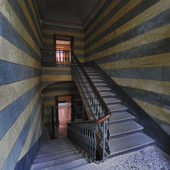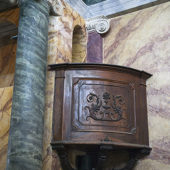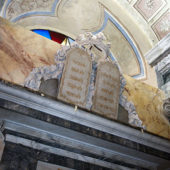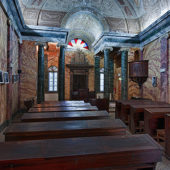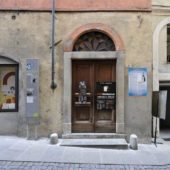Now managed by the Jewish Community of Turin, this synagogue was used only occasionally post WW II. Since re-dedication in 2006 it has been more actively used.
Bishop Maximums, in the fourth century, recorded the presence of Jews in Turin. There is no further evidence of Jews in the city until 1424, when the French Jewish physicians and bankers Elias Alamanni and Amedeo Foa, moved there with their families. They received pontificate patent and ducal privileges and finally, the council provided them with authorization to settle there. The two documents confirming this are bank paperwork and a document indicating that it was forbidden for Jews to be injured or insulted.
Soon other Jewish bankers moved into the area and a small community was formed. In 1425 Jews were only allowed to live in a specific area where they could be “watched carefully,” and prevented from lending money at excessive rates of interest. In 1430 Duke Amadeus VIII of Savoy issued statues regulating not only Jewish residences, but also synagogues, civil and criminal jurisdiction and relations with Christians. Jewish men were required to wear a distinctive armband. For the following four centuries, Savoy regulations upon Jews in Turin fluctuated between stringent to lenient. Jewish money lending was allowed in Turin for a longer period of time than anywhere else in Italy; however, the Jews paid exorbitantly high taxes for the privilege.
In 1560 and 1566 Duke Emmanuel Philibert decreed that all Jews be expelled; however, this was nullified by influential people and by the required Jewish annual payment of 20,000 florins. From 1561 a guardian was appointed to the Jews and in some cases, represented them. The Duke chose the guardian from amongst his senators from 1603 to 1626. Thereafter, names for the guardianship were submitted by the Jews. The majority of Jews involved in money lending were in close economic cooperation with the dukes of Savoy and extended them large loans. In 1624 there were nine Jewish banks in Turin. In 1662 the Talmud Fraternity was founded.
After the death of Charles Emmanuel II in 1679, the reigning duchess, Maria Giovanna of Nemours, decreed the establishment of the ghetto. A year later 750 Jews were forced to live in a building which had previously been used as a hospital for beggars. By 1702 the Jewish population of Turin reached 800. In the 17th and 18th centuries Jews were encouraged to engage in the production and sale of fabrics. In 1723 and 1729, Victor Amadeus II reinforced the harsh regulations inflicted upon the Jews in 1430 causing deterioration of their economic well being. Yet by 1794, the Jewish population increased to approximately 1,300. Turin continued to produce outstanding scholars, particularly in the 18th century: Joshua Colon, Isaac Formiggini, Abraham Sanson Fubini, Michael Jonah, Gabriel Pontremoli, Jacob Segre and Daniel Valabrega.
The French Revolution brought the first real breath of liberty. After the annexation to France in 1798, the Jews of Turin experienced greater liberty and no longer had to live in the ghetto. With the fall of Napoleon in 1814, Victor Emmanuel I reinforced the previous discriminatory regulations; however, many Jews lived outside the ghetto and many men did not wear the distinguishing armband. On March 29, 1848, the Jews were granted emancipation from the ghetto, which in great part may have been due to the efforts of M. D’Azeglio’s booklet, Dell’emancipazione degli Israeliti, which inspired many Jews to fight for their freedom. This outcome encouraged Jews in the other Piedmont towns to fight for their emancipation. From 1871 to 1901 the Turin’s Jewish population grew from 4,500 to 5,700. In order to escape the Nazis many Jewish families in Turin were forced to leave their homes between 1941 and 1943. Most often they hid in the countryside or mountains until the Liberation of the North of Italy in the late April 1945. In spite of these precautions, many Piedmontese Jews lost their lives in the war.Ivrea Synagogue is one of four small town synagogues currently under the jurisdiction of the Turin Jewish community today.
A Synagogue in Ivrea was dedicated in 1875, but because it was so large, from its inception, it was rarely used. The Jewish Community recently made an agreement with the “Comune” (City Hall), to restore the smaller building for worship services, in exchange for allowing the community to use the main sanctuary to host local events. Exactly 131 years after the synagogue was first dedicated, on September 24, 2006, the smaller sanctuary was dedicated with a Torah dedication, and it is now being used to celebrate High Holy days. This was the first REFORM High Holy Day service held in a traditional Italian synagogue – and it was packed! The 200-year-old Torah was donated by the Pollack Family from Detroit. It had originally been penned by a North African scribe in Valish (Sephardic) script, then donated to a yeshiva in Israel in 1948. The Torah scroll has recently been restored by Rabbi Moshe Druin.
The synagogue is situated on a cobblestone lane in the old ghetto area of Ivrea. The building’s exterior is nondescript, with a cement colored-façade. There are no plaques or distinguishing marks to indicate that this is a synagogue. However, inside the prayer room, the elegance and beauty is impressive. The walls are tan and darker brown ‘tiger-stripe’ marble, with reddish-brown pilasters and green marble columns, with grey and green marble coving. The ceiling is barrel-vaulted, spectacularly hand-painted in Baroque design. A small round stained-glass window with a star design is situated in the center of the ceiling. The Aron Kodesh at the far wall is from the late 19th century. It is beautifully hand carved from wood and its doors are decorated with a censer, the menorah, the showbread table, crowned with the twin tablets engraved in Hebrew with The Ten Commandments. Above the Aron Kodesh is a semi-circular stained-glass window. The tivah (reader’s desk), simply carved of wood, sits on the platform in front of the Aron Kodesh. A small, five-paneled balustrade is situated between the congregation and the tivah. Old, carved wood pews fill the sanctuary. The women’s gallery is upstairs at the back of the prayer-room.



